| 1 | Tiger rattlesnake |
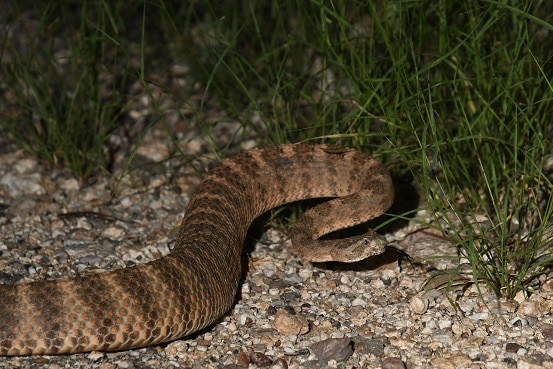
The most toxic rattlesnake species worldwide, just edging out the South American rattlesnake (Crotalus durissus) in the deadliness stakes. The latter has an LD50 toxicity rating of 0.17mg, while the tiger rattlesnake reaches 0.06mg. To top it off, this is a rare rattlesnake to have a neurotoxic venom, alongside some bonus muscle-attacking myotoxins. The tiger rattlesnake has an unusually simple venom, with only 15 genes driving toxin production, yet it still manages to be utterly deadly.
Tiger rattlesnakes are found in the Sonoran desert of Arizona and northern Mexico. Rather than forests, they prefer dry open areas, such as short grasslands, rocky canyons, bajadas, and dry foothills – the kind of landscapes featured in hundreds of westerns.
It’s unlikely that you’ll meet this rattlesnake unless hiking in a national park, or stumbling around the desert aimlessly in search of water. Nevertheless, the tiger rattlesnake is abundant in the parched outskirts of Tucson and Phoenix, and people parking their cars on highways are at particular risk.
Tiger rattlesnakes are a fairly short species, at a maximum of 88.5cm. Their rattle is especially small as a proportion of body length, and their head is the smallest of any rattlesnake species. This is used to probe into rock crevices for prey, before seizing them with their hollow fangs. Tiger rattlesnakes prey on a mixture of mammals and reptiles, with their favourites being pocket mice and kangaroo rats.
Recently, a completely new population of tiger rattlesnake was discovered in the southern Peloncillo mountains of Arizona. In only 2019, they were discovered in New Mexico for the first time ever, in the extreme southwest (Hidalgo County), just 0.1 miles east of the Arizona border. After all this time, there’s still new snake discoveries waiting to be made in the USA.
| 2 | Sidewinder rattlesnake |
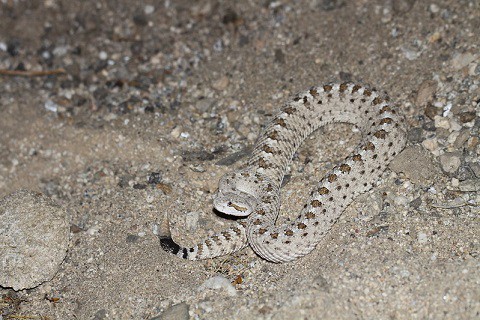
The most-desert adapted rattlesnake worldwide. This species is named for its signature locomotion style: travelling sideways with only two tiny points of its body touching the sand at once, ensuring that the least possible area of its body is exposed to the scorching heat of the desert surface. Sidewinders don’t just live in arid semi-desert like the tiger rattlesnake, but fully-fledged white sand dunes, such as the Mesquite Flats of Death Valley.
Sidewinder rattlesnakes occupy four states: California, Nevada, Arizona and southwest Utah. They’re an instantly recognisable species, both for their sand-coloured scales and the sharp horns above their eyes. Rather than piercing enemies, these horns are believed to be protecting their eyes from sunlight.
Due to their parched habitats, this rattlesnake relies more on lizards than some, making up 50% of their calories. The banded gecko is one favourite, and among mammals, they especially enjoy kangaroo rats.
At a maximum of 82.4cm, this species is far shorter than any of the diamondback rattlers. Being so remote, sidewinder bites are rare, but can be severe if they do occur. A 56 year old man bitten in 2014 experienced extreme nausea, a burning pain up to his groin, and unsteady feet lasting for 3 days. This man was somehow bitten on the foot, despite the precaution of tough leather boots.
| 3 | Rock rattlesnake |
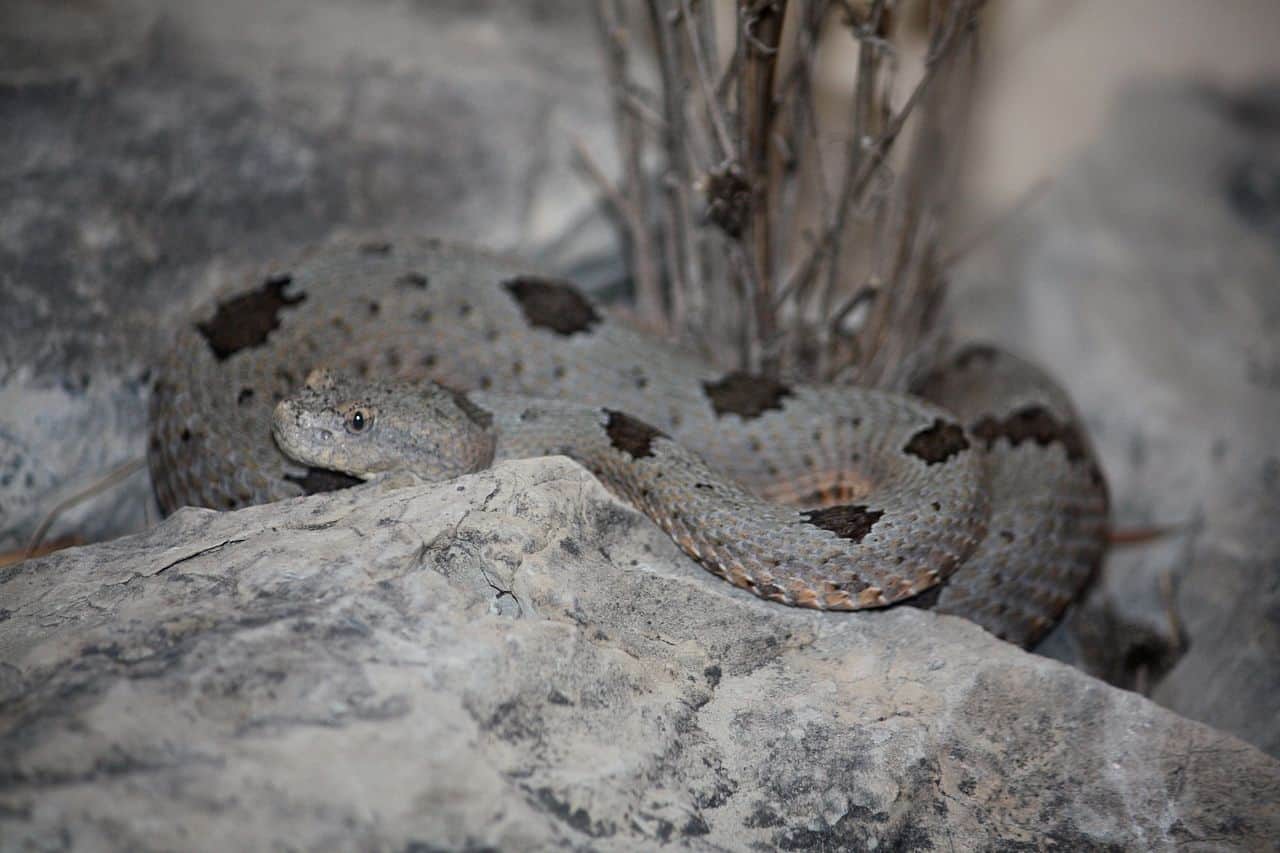
One of the least likely rattlesnakes to encounter in the southern US neighbourhood. Rock rattlesnakes (Crotalus lepidus) are found in 3 states: southwest Texas, southern New Mexico and far southeast Arizona. They’re found only in remote spots far from any civilisation, specifically rocky outcrops and isolated scree slopes in deserts. They also appear on rocky streambeds, and rocky slopes within montane conifer forests.
This is the greyest rattlesnake of the southern US, and this is perfect for blending with their rocky habitats. Crotalus lepidus can rest on its rocky desert slopes for hours, soaking up the warm sunlight, before vanishing into dark crevices later.
Rocky rattlesnakes are relatively short, averaging at 60-70cm. Males are longer than females, and the overall record is 82.8cm. With such superb camouflage, the rock rattlesnake has no need for all out aggression. But if they do bite, the symptoms include pain, nausea, soft tissue swelling, and haemorrhaging.
Fortunately, bites are very rare, as they inhabit such remote spots. The main peril is to hikers, scrambling over isolated rocky slopes on a glorious day out. This is a rare rattlesnake to favour reptiles, which made up 55.4% of their diet according to a 2009 study.
| 4 | Southwestern speckled rattlesnake |
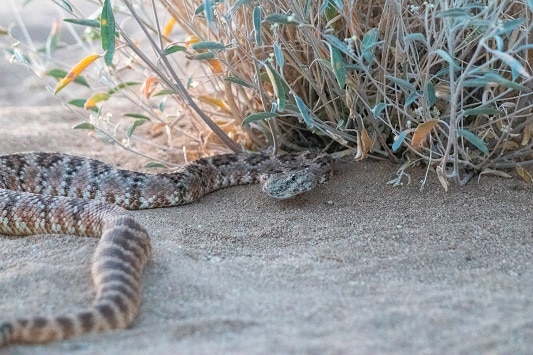
Another rattlesnake with a love of steep rocky slopes, but its range doesn’t overlap with the rock rattlesnake further east. With no competitors, this species seems to have claimed the rocky slope habitat niche for its own. Southwestern speckled rattlesnakes (Crotalus pyrrhus) live in western Arizona, Nevada, Utah and southern California. Unlike the red diamond rattlesnake they coexist with, they only rarely stray to gentle scrubland or cactus country, much preferring rocky canyons or scree slopes within deserts.
Crotalus pyrrhus is also known as the bleached rattlesnake or pallid rattlesnake, and on a gravelly slope, their camouflage can be supreme. This is an abundant rattlesnake, which isn’t endangered in the slightest. They’re also one of the longer southern rattlesnakes, at a maximum of 132cm.
Crotalus pyrrhus has the usual rattlesnake reliance on mammals, at 80.8% of their diet in one study. At 39.4% of prey, they were unusually reliant on terrestrial squirrels.
Officially, the southwestern speckled rattlesnake has a relatively weak venom, at an LD50 rating of 2.7mg versus 0.18mg for the Mojave rattlesnake. However, a patient bitten in Phoenix Mountains, Maricopa County ended up having part of his middle finger amputated. Bites may not be fatal, but they can be lifechanging.
| 5 | Red diamond rattlesnake |
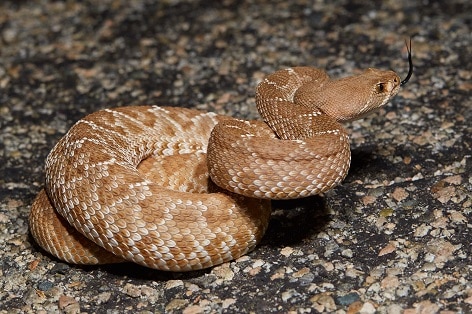
A species of California as well as Baja California (Mexico) to the south. The red diamond rattlesnake (Crotalus ruber) inhabits just one US state, yet is extremely abundant in the southern parts of California. They appear in various dry habitats, such as semi-deserts, pine oak woods, and tropical semi-deciduous forests. However, their favourites are easily scrubland, particularly scrubland of sage and chaparral, as the soils here are perfect for their rodent prey to burrow in.
Red diamond rattlesnakes reach 162.5cm, making them one of the larger species. They’re also the most mammal-dependent rattlesnake of the southern USA. A 2012 study found that red diamond rattlesnakes derive 91.6% of their prey from mammals, particularly rodents, with an additional 7.5% coming from reptiles and 0.9% from birds.
Crotalus ruber is an intelligent hunter, using semi-ambush tactics. They don’t wait in a single spot and hope for prey to wander past, but actively seek out burrows and well-trodden rodent trails. They then wait in ambush posture just next to those spots, waiting for prey to appear.
Red diamond rattlesnakes are even smart enough to hide below prickly pear cacti, in order to shield themselves from predators, which are forced to back off for fear of getting spiked. Their venom is relatively mild, with an LD50 score of 9.21mg, but the venom yield is high, at up to 364mg. This rattlesnake specialises in haemorrhaging rather than brain-frazzling neurotoxins. Of this list, the only species they overlap with is the southwestern speckled rattlesnake.
| 6 | Black-tailed rattlesnake |
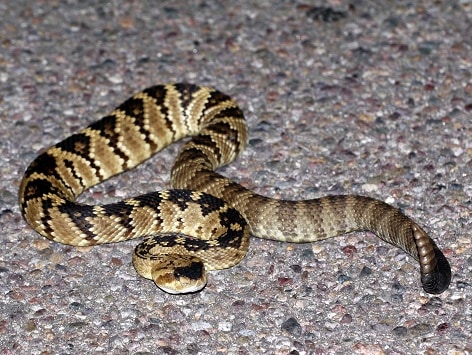
This timid species is the second longest of our list, with a maximum recorded size of 152.4cm. Black-tailed rattlesnakes are found in Arizona, New Mexico and southwest Texas, as well as a huge swathe of northern Mexico. They’re extremely easy to recognise, due to their namesake jet black tail, as well as midnight markings adorning their face.
Black-tailed rattlesnakes might be large, but they have a calm personality, and are reluctant to bite. They also have one of the weakest venoms. When a 12 year old girl was bitten on the foot in her backyard, she experienced swelling and pain which eventually progressed to above her knee. However, there were no systemic symptoms, not even vomiting or dizziness. There was no necrosis or blisters; the worst effect was a persistent numbness in her foot.
Black-tailed rattlesnakes generally live in mountainous areas, such as rocky canyons, or high altitude pine forests. In lower areas, they sometimes inhabit semi-deserts. Their diet mostly consists of small mammals, with lizards eaten occasionally.
The black-tailed rattlesnake actually consists of two very similar-looking species, a western and eastern form. Crotalus molossus inhabits Arizona and extreme southwest New Mexico. Crotalus ornatus, the newly recognised species, inhabits most of New Mexico and southwest Texas. Both share the same jet black tail and facial markings.
| 7 | Ridge-nosed rattlesnake |
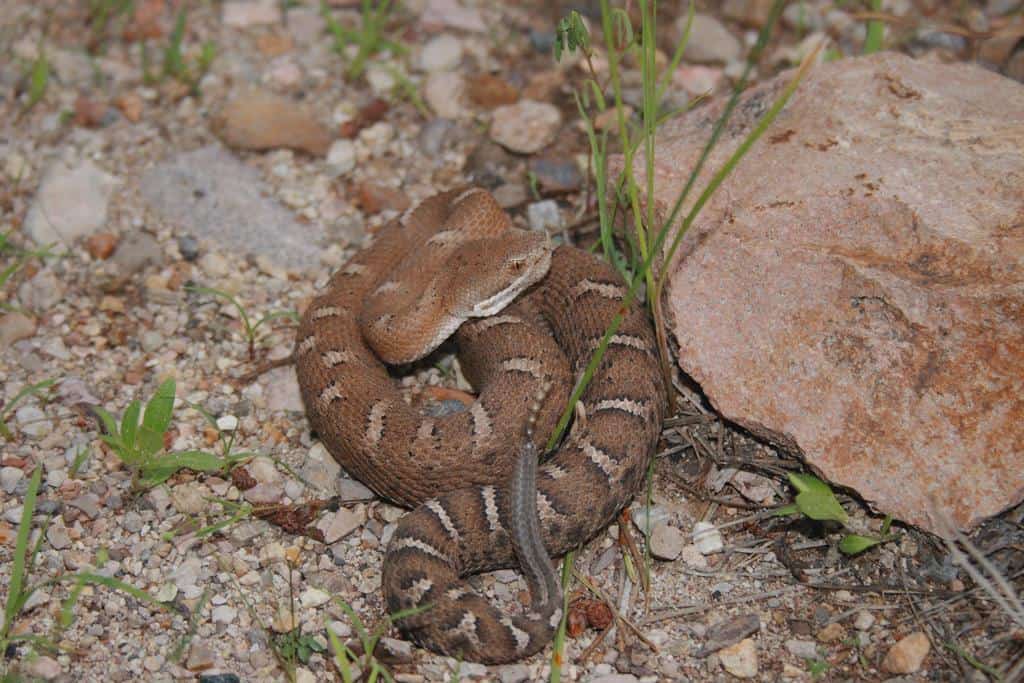
One of the USA’s rarest rattlesnakes. This little known species lives solely in “sky islands”: tall mountain ranges surrounded on each side by desert, in remote places far from human settlements. The ridge-nosed rattlesnake (Crotalus willardi) appears in southeast Arizona and southwest New Mexico, as well as a chunk of northern Mexico. The Santa Rita, Patagonia and Huachuca mountains of Arizona are among their main hotspots, and they’ve been found at altitudes of up to 2800 metres.
Within these mountains, Crotalus willardi is most common in well-vegetated canyons, often with an abundance of pine forests, perhaps ones that 19th century outlaws would have hidden in back in the day. With their brown background overlaid with thin white stripes, this is an easy rattlesnake to recognise. The ridge-nosed rattlesnake is also the second smallest member in the southern US, averaging at just 30-60cm, with a record of 67cm.
Consequently, their fangs don’t spew out much venom, limiting the danger. When one 57 year old man was bitten on the hand, the worst symptom was swelling that extended halfway up the bicep. He recovered fully within 3 days.
The ridge-nosed rattlesnake is another lizard-eating, acquiring 50.7% of their calories from reptiles (study). Only 12.7% consisted of mammals, while 28.2% was birds. They also had the unusual prey of centipedes (8.2%). This rattlesnake’s first instinct is to crawl away when confronted rather than fight back viciously.
| 8 | Mojave rattlesnake |
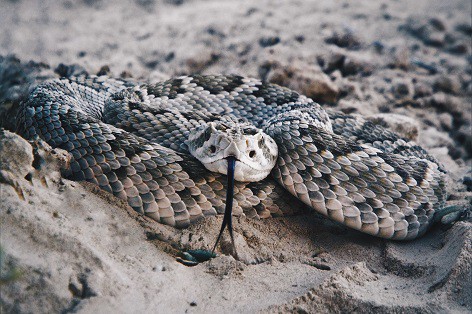
The main desert-surfing rattlesnake after the sidewinder. In the USA, Mojave rattlesnakes are found in Texas, Nevada, New Mexico, Arizona, California and extreme southwest Utah. They’re not quite as heat-adapted as sidewinders, but they’re well adapted to scorching barren wastes, as well as semi-deserts and dry, sloping grassland with wide open views stretching far into the distance.
Mojave rattlesnakes average at 100cm, with a record of 137.3cm. Their diet is biased in favour of mammals, but less overwhemingly than red diamond rattlesnakes. One study found that 19 individuals contained mammal remains, and 15 contains reptile remains. Confirmed prey include silky pocket mice and spotted ground squirrels.
Mojave rattlesnakes are famous for a split in their venom. This species has two distinct venom types within the same species. Venom A is rich in mojavetoxin, a powerful neurotoxin which causes difficulty breathing and vision problems. Venom B, meanwhile, is mostly haemorrhagic and proteolytic, causing spontaneous bleeding and cleaving through tissues. Venom A is more common in California while venom B is typically found in Arizona, but there’s even variations county by county. This makes the Mojave rattlesnake an extremely unpredictable species.
In its type A form, the Mojave rattlesnake is one of the deadliest species of all, potentially killing human beings via respiratory failure. Neurotoxins are uncommon in rattlesnakes; the tiger rattlesnake is another rare one to contain them. Fortunately, deaths are rare, as the standard US viper antivenom (CroFab) is manufactured using Mojave rattlesnake venom A.
| 9 | Arizona black rattlesnake |
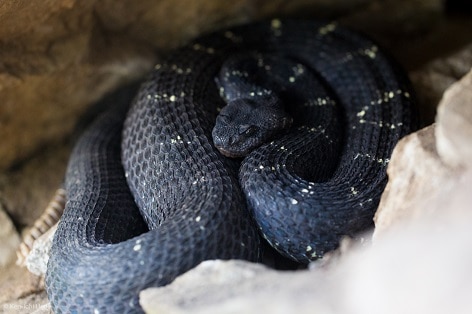
This endangered rattlesnake stands out by being almost completely black, except for a series of razor thin, starry white bands. The Arizona black rattlesnake (Crotalus cerberus) is easily the rarest member in the southern US. They live almost exclusively at high elevations, in “sky island” forested regions within national parks, reaching a maximum altitude of 2743 metres, and appearing no lower than 913 metres.
Arizona black rattlesnakes can be found in rugged realms such as Coronado National Forest, Tonto NF, and Prescott NF. They also live in far western New Mexico, in the Gila Wilderness zone. Crotalus cerberus is medium in length for our list, with the maximum confirmed size being 121.9cm. Compared to most rattlesnakes, they prefer cooler, moister conditions – hence the high elevations.
Arizona black rattlesnakes have a mostly proteolytic venom, causing local damage to skin tissue. One study examined 7 rattlesnake species of the western US, including the prairie rattlesnake. The Arizona black rattlesnake had the highest quantities of metalloproteases, which cleave through bonds in amino acids to dissolve proteins into rubble. Yet its venom was the weakest of the 7 towards mice, with an LD50 score of 5.4mg vs 0.36mg for the midget faded rattlesnake (the strongest), and 1.55mg for the prairie rattlesnake.
Restricted to two states, this is the most endangered rattlesnake in the United States, as its forested National Parks have steadily degraded over time. A 2016 study put them on an extinction trajectory.
| 10 | Twin-spotted rattlesnake |
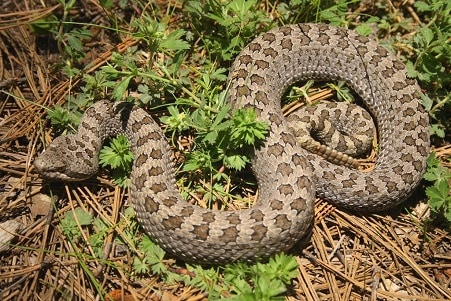
This 50-60cm rattlesnake mostly lives in Mexico, with only a tiny portion of land in the USA. It lives solely in Arizona, and even then, solely within the mountains of Chiricahua, Huachuca, Pinaleno, Dos Cabezas, and Santa Rita.
The twin-spotted rattlesnake (Crotalus pricei) reaches high altitudes of 2900 metres, and is the most reptile-loving rattlesnake of the southern USA. When tested in Arizona’s Chiricahua Mountains, their diet consisted of 74% reptiles. Its favourite prey of all is Yarrow’s spiny lizard, which is now fighting back by evolving venom resistance.
On their mountains, Crotalus pricei is at home in pine-oak woodland, coniferous woods, grassy and brushy areas, and rocky slopes alike. Within forests, they have a tendency to hang out in tree stumps. Despite this rarity in the US, they can be abundant in perfect habitats, with several appearing inside just a few square metres.
This is the southern USA’s shortest rattler, with a maximum recorded length of 66cm, less than 50% of the black-tailed rattlesnake’s record. It has a triangular head, and its colours are non-flashy, consisting of beige, light brown or grey patterns. Unlike the Arizona black rattlesnake, this species isn’t endangered; the population was perfectly stable when assessed in 2007.
